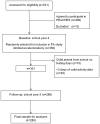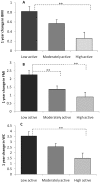MVPA is associated with lower weight gain in 8-10 year old children: a prospective study with 1 year follow-up
- PMID: 21552554
- PMCID: PMC3084238
- DOI: 10.1371/journal.pone.0018576
MVPA is associated with lower weight gain in 8-10 year old children: a prospective study with 1 year follow-up
Abstract
Background: Studies relating physical activity (PA) to weight gain in children have produced mixed results, although there is some evidence for stronger associations with more intense physical activities. The present study tested the hypothesis that weight gain over one year in 8-10 year olds would be more strongly predicted by moderate and vigorous physical activity (MVPA) than total physical activity (total PA) or sedentary behaviour.
Methodology: Participants were 280 children taking part in the Physical Exercise and Appetite in Children Study (PEACHES). Weight status was assessed using body mass index (BMI), fat mass index (FMI), and waist circumference (WC) in school Year 4 (baseline; age 8.7 yrs) and Year 5 (follow-up; age 9.7 yrs). Physical activity was measured at baseline using the Actigraph GT1M accelerometer to assess total PA (mean accelerometers counts per minute), MVPA; ≥ 4000 counts per minute) and sedentary time (<100 counts per minute).
Principal findings: After adjustment for baseline BMI, SES, sex and ethnicity, MVPA was significantly associated with follow-up BMI (adjusted β = -0.07; p = 0.002). This association was independent of total PA or sedentary time. Similar results were observed for FMI; again MVPA was significantly associated with follow up FMI (β = -0.16; p = 0.001) independent of total PA or sedentary time. The pattern was similar for WC (β = -0.07), but the association between MVPA and WC did not reach significance at p = 0.06.
Conclusion: The results of this study strongly support promotion of MVPA in children.
Conflict of interest statement
Figures


References
-
- World Health Organisation. Global strategy on diet physcial activity and health. 2004. Available: www.who.int/dietphysicalactivity/strategy. Accessed 2011 Jan 31.
-
- Barsh GS, Farooqi IS, O'Rahilly S. Genetics of body-weight regulation. Nature. 2000;404:644–651. - PubMed
-
- Ebbeling CB, Pawlack DB, Ludwig DS. Childhood obesity: public-health crisis common sense cure. Lancet. 2002;360:473–482. - PubMed
-
- Fogelholm M, Kikkonene-Harjula K. Does physical activity prevent weight gain - a systematic review. Obes Rev. 2000;1:95–111. - PubMed
-
- Wareham NJ, van Sluijs EMF, Ekelund U. Physical activity and obesity prevention: a review of the current evidence. Proc Nut Soc. 2005;64 - PubMed
Publication types
MeSH terms
Grants and funding
LinkOut - more resources
Full Text Sources

